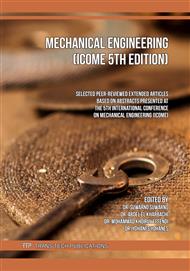[1]
Boonthum Wongchai.: The Effect of the Configuration of the Screw Fixation on the Interfragmentary Strain, American Journal of Applied Sciences, vol. 9, no. 6, pp.842-845 (2012).
DOI: 10.3844/ajassp.2012.842.845
Google Scholar
[2]
Saidpour, S.H., Richardson, M.O.W.: Glass fibre coating for optimum mechanical properties of vinyl ester composite. Composites Part A.;28; pp.495-504 (1997).
DOI: 10.1016/s1359-835x(97)00071-7
Google Scholar
[3]
Triyono, J., Alfiansyah, R., Sukanto, H., Ariawan, D., & Nugroho, Y.: Fabrication and characterization of porous bone scaffold of bovine hydroxyapatite-glycerin by 3D printing technology. Bioprinting, e00078.
DOI: 10.1016/j.bprint.2020.e00078
Google Scholar
[4]
Toro, P., Quijada, R., Yazdani-Pedram, M., Arias, J.L.: Eggshell, a new bio-filler for polypropylene composites. Mater. Lett. 61 (22), 4347–4350. http://dx.doi.org/10.1016/j. matlet.2007.01.102 (2007).
DOI: 10.1016/j.matlet.2007.01.102
Google Scholar
[5]
Böstman O., Pihlajamäki H.: Clinical biocompatibility of biodegradable orthopaedic implants for internal fixation: a review. Biomaterials ;21:2615-21 (2000).
DOI: 10.1016/s0142-9612(00)00129-0
Google Scholar
[6]
Eppley BL., Sadove AM.: A comparison of resorbable and metallic fixation in healing of calvarial bone grafts. Plast Reconstr Surg 1995;96:316Y322 (1995).
DOI: 10.1097/00006534-199508000-00009
Google Scholar
[7]
Bos RRM., Rozema FR., Boering G., et al.: Degradation and tissue reactions to biodegradable poly(L-lactide) for use as an internal fixation of fractures: a study in rats. Biomaterials;12:32Y38 (1991).
DOI: 10.1016/0142-9612(91)90128-w
Google Scholar
[8]
Yusra Firdaus.: Kenapa Patah Tulang Pada Anak Lebih Cepat Sembuh Dari pada Orang Dewasa, Kesehatan Muskuloskeletal Patah Tulang, https://hellosehat.com/ last accessed 2019/6/2.
DOI: 10.46576/djtechno.v3i2.2735
Google Scholar
[9]
Jun-Wei Lil., et.al.: Application of Biodegradable Materials in Orthopedics, Journal of Medical and Biological Engineering https://doi.org/10.1007/s40846-019-00469-8, Taiwanese Society of Biomedical Engineering (2019).
Google Scholar
[10]
Pietrzykowska, E., Romelczyk-Baishya, B., Wojnarowicz, J., Sokolova, M., Szlazak, K., Swieszkowski, W.,Lojkowski, W.:Preparation of a Ceramic Matrix Composite Made of Hydroxyapatite Nanoparticles and Polylactic Acid by Consolidation of Composite Granules. Nanomaterials, 10(6), 1060.
DOI: 10.3390/nano10061060
Google Scholar
[11]
T. Xu, Q., Yao, J.M. Miszuk., H.J. Sanyour., Z. Hong., H. Sun., H. Fong.: Tailoring weight ratio of PCL/PLA in electrospun three-dimensional nanofibrous scaffolds and the effect on osteogenic differentiation of stem cells, Colloids and Surfaces B: Biointerfaces. Volume 171, 1 November 2018, Pages 31-39 (2018).
DOI: 10.1016/j.colsurfb.2018.07.004
Google Scholar
[12]
Ferri, J. M., Fenollar, O., Jorda-Vilaplana, A., García-Sanoguera, D., & Balart, R.: Effect of miscibility on mechanical and thermal properties of poly(lactic acid)/ polycaprolactone blends. Polymer International, 65(4), 453–463.
DOI: 10.1002/pi.5079
Google Scholar
[13]
Guangyao Xiong., Yanjiao Nie., Dehui Ji, Jing Li., Chunzhi Li., Wei Li., Yong Zhu., Honglin Luo., Yizao Wan.: Characterization of biomedical hydroxyapatite/magnesium composites prepared by powder metallurgy assisted with microwave sintering. Current Applied Physics, 16(8), 830–836.
DOI: 10.1016/j.cap.2016.05.004
Google Scholar
[14]
Balbinotti P., Gemelli E., Buerger G., de Lima SA., de Jesus J., Camargo NHA., et al.: Microstructure Development on Sintered Ti/HA Biocomposites Produced by Powder Metallurgy. Mater Res-Ibero-Am J. ;14:384-93 (2011).
DOI: 10.1590/s1516-14392011005000044
Google Scholar
[15]
Mamun A., Rahman SMM., Roland S., Mahmood R.: J Polym Environ 26:3511(2018).
Google Scholar
[16]
Elzein T., Nasser-Eddine M., Delaite C et al.: J Colloid Interface Sci 273:381 (2004).
Google Scholar
[17]
Hossain KMZ, Parsons AJ, Rudd CD, Ahmed I, Thielemans W.: Mechanical, crystallisation and moisture absorption properties of melt drawn polylactic acid fibres. Eur Polym J 53:270–281 (2014).
DOI: 10.1016/j.eurpolymj.2014.02.001
Google Scholar
[18]
Navarro-Baena, I., Sessini, V., Dominici, F., Torre, L., Kenny, J. M., & Peponi, L.: Design of biodegradable blends based on PLA and PCL: From morphological, thermal and mechanical studies to shape memory behavior. Polymer Degradation and Stability, 132, 97–108.
DOI: 10.1016/j.polymdegradstab.2016.03.037
Google Scholar
[19]
Boland ED, Pawlowski KJ and Barnes CP et al.: Electrospinning of bioresorbable polymer for tissue engineering scaffolds[M]. USA Washington: AMER CHEMICAL SOC, 918: 188-204 (2006).
Google Scholar
[20]
Haroosh HJ, Chaudhary DS and Dong Y.: Electrospun PLA/PCL fibers with tubular microclay: Morphological and structural analysis [J]. Journal of Applied Polymer Science; 124(5): 3930-3939 (2012).
DOI: 10.1002/app.35448
Google Scholar
[21]
Hou, A.-L., & Qu, J.-P.: Super-Toughened Poly(lactic Acid) with Poly(ε-caprolactone) and Ethylene-Methyl Acrylate-Glycidyl Methacrylate by Reactive Melt Blending. Polymers, 11(5), 771.
DOI: 10.3390/polym11050771
Google Scholar
[22]
Wachirahuttapong, S., Thongpin, C., & Sombatsompop, N.: Effect of PCL and Compatibility Contents on the Morphology, Crystallization and Mechanical Properties of PLA/PCL Blends. Energy Procedia, 89, 198–206.
DOI: 10.1016/j.egypro.2016.05.026
Google Scholar
[23]
Jiao, Z., Luo, B., Xiang, S., Ma, H., Yu, Y., & Yang, W.: 3D printing of HA / PCL composite tissue engineering scaffolds. Advanced Industrial and Engineering Polymer Research.
DOI: 10.1016/j.aiepr.2019.09.003
Google Scholar
[24]
Albertsson, A.C.: Degradable Aliphatic Polyesters., Vol. 157., Springer, hal 179 (2020). 24.
Google Scholar
[25]
Noroozi, N., Schafer, L. L. and Hatzikiriakos, S. G.: Thermorheological properties of poly (ε-caprolactone)/polylactide blends. Polym Eng Sci; p.2348–2359 (2012).
DOI: 10.1002/pen.23186
Google Scholar
[26]
P. Molinero-Mourelle., S. Canals, M. Gomez-Polo., M. Fernanda Sola-Ruiz., J. del Rio Highsmith.: A. Celemin Vinuela, Polylactic Acid as a Material for Three-Dimensional Printing of Provisional Restorations, International Journal of Prosthodontics 31(4) 349-350 (2018).
DOI: 10.11607/ijp.5709
Google Scholar
[27]
Liao, Y., Liu, C., Coppola, B., Barra, G., Di Maio, L., Incarnato, L., & Lafdi, K.: Effect of Porosity and Crystallinity on 3D Printed PLA Properties. Polymers, 11(9), 1487.
DOI: 10.3390/polym11091487
Google Scholar
[28]
Callister Jr., William D.: Materials Science And Engineering An Introduction, 8th Edition, New Jersey : John Wiley & Sons, Inc, Hoboken (2009).
Google Scholar



